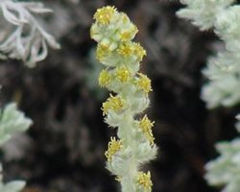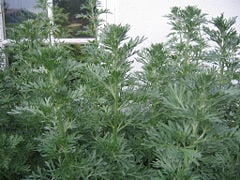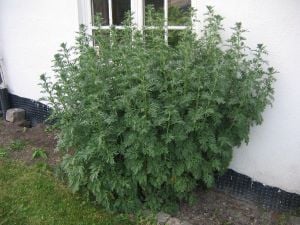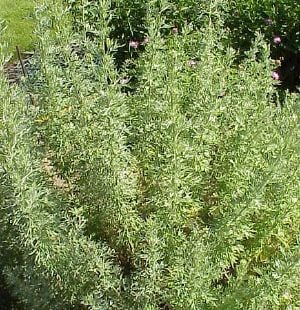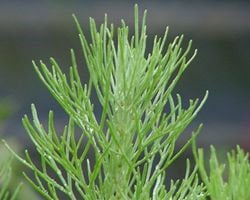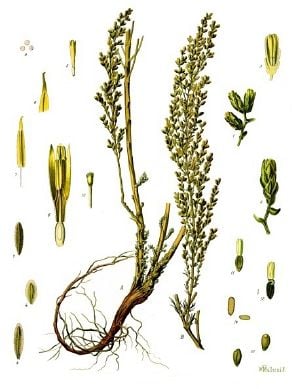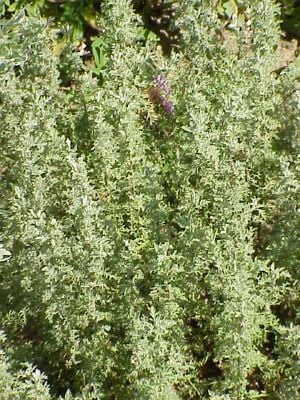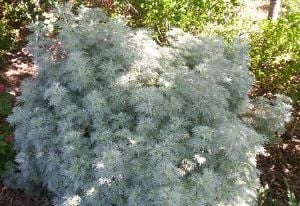Artemisia (genus)
| Artemisia | ||||||||||||
|---|---|---|---|---|---|---|---|---|---|---|---|---|
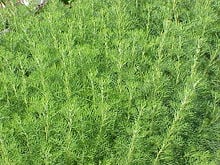 Artemisia dracunculus
| ||||||||||||
| Scientific classification | ||||||||||||
| ||||||||||||
|
See text |
Artemisia is a large, diverse genus of mostly perennial and aromatic herbs and shrubs in the daisy family Asteraceae, characterized by alternate leaves and small flower heads. Many of the perhaps 400 species in the genus are valued for their essential oils or as ornamentals. Well-known species include wormwood, mugwort, tarragon, and sagebush.
Many of the plant components that are so vital to the survival and reproduction of the plants—leaves, flowers, volatile oils—also provide a larger value for humans. The leaves and essential oils are used medicinally, including the production of an anti-malarial compound from Artemisia annua. Various species are used for culinary purposes, with A. absinthium used in vermouth and absinthe, and A. dracunculus (tarragon) popular in French cuisine. Although many species are wind-pollinated, there is evidence of insect pollination for some species (Tkach et al. 2007), with the flowers offering nectar to the insects in exchange for pollination. The attractive foliage and colorful flower-heads of some species make them desirable ornamental plants.
Description
Asteraceae family
The family Asteraceae or Compositae, to which Artemisia belongs, is known as the aster, daisy, or sunflower family. It is the largest family of flowering plants in terms of number of species. According to the Royal Botanical Gardens of Kew, the family comprises more than 1,600 genera and 23,000 species. The name 'Asteraceae' is derived from the type genus Aster and refers to the star-shaped flower head of its members, epitomized well by the daisy. "Compositae," an older but still valid name (McNeill et al. 2006), means "composite" and refers to the unique inflorescence Inflorescences: How flowers are arranged on the stem The Seed Site. Retrieved June 11, 2008. (described below).
Asteraceae is a taxon of dicotyledonous flowering plants. In addition to the daisy and members of Artemisia, other well-known members of the family include lettuce, chicory, globe artichoke, safflower, dandelion, ragwort, and sunflower.
Plants belonging to the Asteraceae Information about Compositae or Asteraceae The Stanford Dahlia Project. Retrieved June 11, 2008. share all the following characteristics (Judd et al. 1999). None of these traits, taken separately, can be considered synapomorphic.
- The inflorescence is an involucrate capitulum (flower head)
- Tubular/disc florets are actinomorphic, ligulate/ray florets are zygomorphic
- Anthers are syngenesious, i.e. with the stamens fused together at their edges, forming a tube
- The ovary has basal arrangement of the ovules
- One ovule per ovary
- The calyx (sepals) of the florets are modified to form a pappus, a tuft of hairs, which often appears on the mature fruit
- The fruit is an achene
- In the essential oils Sesquiterpenes are present, but iridoids are lacking.
The most common characteristic of all these plants is a flower head (formerly composite flower), which is often thought to be a single flower but is actually a densely packed cluster of numerous, small, individual flowers, usually called florets (meaning "small flowers"). Plants with flower heads include daisies and sunflowers. Flower heads in members of the family Asteraceae typically comprise one or both of two kinds of florets. Florets occupying the outer perimeter of a flower head like that of a sunflower each possess a long strap-like petal, termed a ligule. Such florets, are called ray florets to distinguish them from the usually more numerous disc florets occupying the inner portion of the flower head (or disc). Each of the disc florets has fused petals forming a tubular corolla.
Artemisia genus
The genus Artemisia contains between 200 and 400 described species. It comprises hardy plants known for their volatile oils. Members of the genus range from dwarf herbaceous plants to tall shrubs. These are mostly perennial plants and are frequently aromatic (Mucciarelli and Maffei 2002). They all have alternate leaves, tubular florets, and small capitula, which usually occur as pendant, racemose, capitate, or paniculate inflorescences, rarely solitary (Mucciarelli and Maffei 2002). The fern-like leaves of many species are covered with white hairs.
They grow in temperate climates of the Northern Hemisphere and Southern Hemisphere, usually in dry or semi-dry habitats. They can be found from the Arctic alpine or mountainous areas to the dry deserts, and dominate the steppe communities of Asia, South Africa, and the New World (Mucciarelli and Maffei 2002). Many species are wind pollinated, although there is evidence for insect pollination in some species based on their having colorful capitula and sticky pollen (Tkach et al. 2007). Some species are self-pollinated (Tkach et al. 2007).
Some botanists split the genus into several genera, but DNA analysis (Watson et al. 2002) does not support the maintenance of the genera Crossostephium, Filifolium, Neopallasia, Seriphidium, and Sphaeromeria. Three other segregate genera, Stilnolepis, Elachanthemum, and Kaschgaria, are maintained by this evidence.
Common names used for several species include wormwood, mugwort, sagebrush, and sagewort, while a few species have unique names, notably tarragon (A. dracunculus) and southernwood (A. abrotanum). Occasionally some of the species are called sages, causing confusion with the Salvia sages in the family Lamiaceae.
Artemisia species are used as food plants by the larvae of a number of Lepidoptera species.
Uses
Artemisia plants are valued for medicinal, ornamental, culinary, and insect-repelling purposes.
The aromatic leaves of various species of Artemisia are medicinal, such as Artemisia absinthium, absinth wormwood or common wormwood, which is used medicinally as a tonic, stomachic, febrifuge, and anthelmintic. Artemisinin, extracted from Chinese wormwood, Artemisia annua, is the active ingredient in the anti-malarial combination therapy 'Coartem', produced by Novartis and the World Health Organization. It is useful for strains of malaria resistant to quinine.
Some Artemisia species are valued for culinary purposes, although most have an extremely bitter taste. Absinth or common wormwood, A. absinthium, in addition to the above-mentioned medicinal purposes, is used in brewing wormwood beer and in such beverages as vermouth and absinthe. The aperitif vermouth (derived from the German word for wormwood, wermut) is a wine flavored with aromatic herbs, but originally with wormwood. Absinthe is a highly potent spirit that contains wormwood. Artemisia arborescens (tree wormwood, or sheeba in Arabic) is a very bitter herb indigenous to the Middle East that is used in tea, usually with mint. A. dracunculus (tarragon) is widely used as a herb, particularly important in French cuisine. It is one of the four fines herbes of French cooking, and particularly suitable for chicken, fish, and egg dishes. Tarragon is one of the main components of Bearnaise sauce.
Artemisia absinthium also is used to repel fleas and moths. The bitterness of the plant also led to its use by wet-nurses for weaning infants from the breast, as in this speech by Shakespeare from Romeo and Juliet Act I, Scene 3:
- Nurse: …
- And she [Juliet] was wean'd, – I never shall forget it, –
- Of all the days of the year, upon that day:
- For I had then laid wormwood to my dug,
- ...
Various Artemisia species are grown as ornamental plants, with the fine-textured ones used for clipped bordering, with their attractive green, grayish, or silver foliage linking or contrasting those plants with stronger colors. All grow best in free-draining sandy soil, unfertilized, and in full sun.
Both absinthe wormwood, Artemisia absinthium, and mugwort, Artemisia vulgaris are used with such religious practices as Wicca, being believed to have multiple effects on the psychic abilities of the practitioner. The beliefs surrounding this genus are founded upon the strong association between the herbs of the genus Artemisia and the moon goddess Artemis, who is believed to hold these powers. She is known also by Diana, Selene, and Phoebe. In Hellenistic culture, Artemis was a goddess of the hunt, and protector of the forest and children.
It is also said that the genus Artemisia (which includes over 400 plants) may be named after an ancient botanist. Artemisia was the wife and sister of the Greek/Persian King Mausolus from the name of whose tomb we get the word mausoleum. Artemisia, who ruled for three years after the king's death, was a botanist and medical researcher, and died in 350 B.C.E. (GHO 2008).
In Russian culture, the fact that Artemisia species are commonly used in medicine, and their bitter taste is associated with medicinal effects, has caused wormwood to be seen as a symbol for a "bitter truth" that must be accepted by a deluded (often self-deluded) person. This symbol has acquired a particular poignancy in modern Russian poetry, which often deals with the loss of illusory beliefs in various ideologies.
Selected species
- Artemisia abrotanum L. – Southernwood, Southern Wormwood, Abrotanum, Lemon Plant
- Artemisia absinthium L. – Absinth or Grand Wormwood, Common Wormwood, used in Absinthe
- Artemisia adamsii Besser
- Artemisia afra – African Wormwood, African Sagebrush
- Artemisia alaskana Rydb. – Alaska Wormwood
- Artemisia alba
- Artemisia alcockii Pamp.
- Artemisia aleutica Hultén – Aleutian Wormwood
- Artemisia amoena Poljakov
- Artemisia annua L. – Annual Wormwood, Sweet Sagewort, Sweet Annie
- Artemisia araxina Takht.
- Artemisia arborescens - Tree Wormwood
- Artemisia arbuscula Nutt. – Little Sagebrush, Low Sagebrush, Black Sage
- Artemisia arctica Less. – Boreal Sagebrush
- Artemisia arctisibirica Korobkov
- Artemisia arenaria DC.
- Artemisia arenicola Krasch. ex Poljakov
- Artemisia argentea (Madeira wormwood ?)
- Artemisia argyi H.Lév. & Vaniot
- Artemisia argyrophylla Ledeb.
- Artemisia armeniaca Lam.
- Artemisia aschurbajewii C.G.Aro
- Artemisia australis Less. – Oahu Wormwood
- Artemisia austriaca Jacq.
- Artemisia avarica Minat.
- Artemisia badhysi Krasch. & Lincz. ex Poljakov
- Artemisia balchanorum Krasch.
- Artemisia baldshuanica Krasch. & Zaprjag.
- Artemisia bargusinensis Spreng.
- Artemisia bejdemaniae Leonova
- Artemisia biennis Willd. – Biennial Sagewort, Biennial Wormwood
- Artemisia bigelovii Gray – Bigelow Sage, Bigelow Sagebrush
- Artemisia borealis Pall.
- Artemisia borotalensis Poljakov
- Artemisia bottnica Lundstr. ex Kindb.
- Artemisia caespitosa Ledeb.
- Artemisia californica Less. – Coastal Sagebrush, California Sagebrush
- Artemisia camelorum Krasch.
- Artemisia campestris L. – Field Wormwood
- Artemisia cana Pursh – Silver Sagebrush
- Artemisia canadensis – Canada Wormwood
- Artemisia capillaris Thunb. – Capillary Wormwood, Yerba Lenna Yesca
- Artemisia carruthii Wood ex Carruth. – Carruth Sagewort, Carruth's Sagebrush
- Artemisia caucasica Willd.
- Artemisia chamaemelifolia Vill.
- Artemisia cina O. Berg & C. F. Schmidt – Santonica, Levant Wormseed
- Artemisia ciniformis Krasch. & Popov ex Poljakov
- Artemisia coarctata (???)
- Artemisia commutata Besser
- Artemisia compacta Fisch. ex DC.
- Artemisia cuspidata Krasch.
- Artemisia czukavinae Filatova
- Artemisia daghestanica Krasch. & Poretzky
- Artemisia demissa Krasch.
- Artemisia depauperata Krasch.
- Artemisia deserti Krasch.
- Artemisia desertorum Spreng.
- Artemisia diffusa Krasch. ex Poljakov
- Artemisia dimoana Popov
- Artemisia dolosa Krasch.
- Artemisia douglasiana Bess. – Douglas' Mugwort, Douglas' Sagewort
- Artemisia dracunculus L. – Tarragon
- Artemisia dubia Wall.
- Artemisia dubjanskyana Krasch. ex Poljakov
- Artemisia dumosa Poljakov
- Artemisia elongata Filatova & Ladygina
- Artemisia eremophila Krasch. & Butkov ex Poljakov
- Artemisia eriantha Ten.
- Artemisia feddei H.Lév. & Vaniot
- Artemisia fedtschenkoana Krasch.
- Artemisia ferganensis Krasch. ex Poljakov
- Artemisia filifolia Torr. – Sand Sagebrush, Sand Sagebush, Silvery Wormwood
- Artemisia flava Jurtzev
- Artemisia franserioides Greene – Ragweed Sagebrush
- Artemisia freyniana (Pamp.) Krasch.
- Artemisia frigida Willd. – Fringed Sagebrush, Fringed Sagewort, Prairie Sagewort
- Artemisia fulvella Filatova & Ladygina
- Artemisia furcata Bieb. – Forked Wormwood
- Artemisia galinae Ikonn.
- Artemisia glabella Kar. & Kir.
- Artemisia glacialis – Glacier Wormwood, Alpine Mugwort
- Artemisia glanduligera Krasch. ex Poljakov
- Artemisia glauca Pall. ex Willd.
- Artemisia glaucina Krasch. ex Poljakov
- Artemisia globosa Krasch.
- Artemisia globularia Cham. ex Bess. – Purple Wormwood
- Artemisia glomerata Ledeb. – Cudweed Sagewort, Pacific Alpine Wormwood
- Artemisia gmelinii Webb ex Stechmann – Gmelin's Wormwood
- Artemisia gnaphalodes Nutt.
- Artemisia gorjaevii Poljakov
- Artemisia gracilescens Krasch. & Iljin
- Artemisia gurganica (Krasch.) Filatova
- Artemisia gypsacea Krasch., Popov & Lincz. ex Poljakov
- Artemisia halodendron Turcz. ex Besser
- Artemisia halophila Krasch.
- Artemisia heptapotamica Poljakov
- Artemisia hippolyti Butkov
- Artemisia hololeuca M.Bieb. ex Besser
- Artemisia hulteniana Vorosch.
- Artemisia incana (L.) Druce
- Artemisia insulana Krasch.
- Artemisia insularis Kitam.
- Artemisia integrifolia L.
- Artemisia issykkulensis Poljakov
- Artemisia jacutica Drobow
- Artemisia japonica Thunb.
- Artemisia juncea Kar. & Kir.
- Artemisia karatavica Krasch. & Abolin ex Poljakov
- Artemisia karavajevii Leonova
- Artemisia kaschgarica Krasch.
- Artemisia kauaiensis (Skottsberg) Skottsberg – Kauai Wormwood
- Artemisia keiskeana Miq.
- Artemisia kelleri Krasch.
- Artemisia kemrudica Krasch.
- Artemisia knorringiana Krasch.
- Artemisia kochiiformis Krasch. & Lincz. ex Poljakov
- Artemisia koidzumii Nakai
- Artemisia kopetdaghensis Krasch. ex Poljakov
- Artemisia korovinii Poljakov
- Artemisia korshinskyi Krasch. ex Poljakov
- Artemisia krushiana Bess. – Krush's Wormwood
- Artemisia kulbadica Boiss. & Buhse
- Artemisia kuschakewiczii C.G.A.Winkl.
- Artemisia laciniata Willd. – Siberian Wormwood
- Artemisia laciniatiformis Kom.
- Artimisia lactiflora
- Artemisia lagocephala (Besser) DC.
- Artemisia lagopus Fisch. ex Besser
- Artemisia latifolia Ledeb.
- Artemisia ledebouriana Besser
- Artemisia lehmanniana Bunge
- Artemisia leontopodioides Fisch. ex Besser
- Artemisia lessingiana Besser
- Artemisia leucodes Schrenk
- Artemisia leucophylla (Turcz. ex Besser) Pamp.
- Artemisia leucotricha Krasch. ex Ladygina
- Artemisia lindleyana Bess. – Columbia River Wormwood
- Artemisia lipskyi Poljakov
- Artemisia littoricola Kitam.
- Artemisia longifolia Nutt. – Longleaf Sagebrush, Longleaf Wormwood
- Artemisia ludoviciana Nutt. – Gray Sagewort, Prairie Sage, White Sagebrush
- Artemisia macilenta (Maxim.) Krasch.
- Artemisia macrantha Ledeb.
- Artemisia macrobotrys Ledeb. – Yukon Wormwood
- Artemisia macrocephala Jacq. ex Besser
- Artemisia macrorhiza Turcz.
- Artemisia maracandica Bunge
- Artemisia maritima L. – Sea Wormwood
- Artemisia marschalliana Spreng.
- Artemisia martjanovii Krasch. ex Poljakov
- Artemisia mauiensis (Gray) Skottsberg – Maui Wormwood
- Artemisia maximovicziana Krasch. ex Poljakov
- Artemisia medioxima Krasch. ex Poljakov
- Artemisia messerschmidtiana Besser
- Artemisia michauxiana Bess. – Michaux Sagebrush, Michaux's Wormwood
- Artemisia mogoltavica Poljakov
- Artemisia mongolica (Besser) Fisch. ex Nakai
- Artemisia mongolorum Krasch.
- Artemisia montana (Nakai) Pamp.
- Artemisia mucronulata Poljakov
- Artemisia multisecta Leonova
- Artemisia namanganica Poljakov
- Artemisia nesiotica Raven – Island Sagebrush
- Artemisia nigricans Filatova & Ladygina
- Artemisia norvegica Fries – Norwegian Mugwort
- Artemisia nova A. Nels. – Black Sagebrush
- Artemisia obscura Pamp.
- Artemisia obtusiloba Ledeb.
- Artemisia oelandica (Besser) Krasch.
- Artemisia olchonensis Leonova
- Artemisia oliveriana J. Gay ex Besser
- Artemisia opulenta Pamp.
- Artemisia packardiae J. Grimes & Ertter – Packard's Wormwood, Succor Creek Sagebrush
- Artemisia pallasiana Fisch. ex Besser
- Artemisia palmeri Gray – San Diego Sagewort
- Artemisia palustris L.
- Artemisia pannosa Krasch.
- Artemisia papposa Blake & Cronq. – Owyhee Sage, Owyhee Sagebrush
- Artemisia parryi Gray – Parry's Wormwood
- Artemisia pattersonii Gray – Patterson's Wormwood
- Artemisia pectinata Pall.
- Artemisia pedatifida Nutt. – Birdfoot Sagebrush
- Artemisia pedemontana Balb.
- Artemisia persica Boiss.
- Artemisia pewzowii C.G.A.Winkl.
- Artemisia phaeolepis Krasch.
- Artemisia polysticha Poljakov
- Artemisia pontica L. – Roman Wormwood, "Petite Absinthe" (used in Absinthe)
- Artemisia porrecta Krasch. ex Poljakov
- Artemisia porteri Cronq. – Porter's Wormwood
- Artemisia prasina Krasch. ex Poljak.
- Artemisia princeps Pamp. – Japanese Mugwort, Yomogi
- Artemisia proceriformis Krasch.
- Artemisia prolixa Krasch. ex Poljak.
- Artemisia punctigera Krasch. ex Poljakov
- Artemisia purshiana Besser
- Artemisia pycnocephala (Less.) DC. – Beach Wormwood
- Artemisia pycnorhiza Ledeb.
- Artemisia pygmaea Gray – Pygmy Sagebrush
- Artemisia quinqueloba Trautv.
- Artemisia remotiloba Krasch. ex Poljakov
- Artemisia rhodantha Rupr.
- Artemisia rigida (Nutt.) Gray – Scabland Sagebrush
- Artemisia rothrockii Gray – Timberline Sagebrush
- Artemisia rubripes Nakai
- Artemisia rupestris L. – Rock Wormwood, Alpine Yarrow
- Artemisia rutifolia Stephan ex Spreng.
- Artemisia saissanica (Krasch.) Filatova
- Artemisia saitoana Kitam.
- Artemisia salsoloides Willd.
- Artemisia samoiedorum Pamp.
- Artemisia santolina Schrenk
- Artemisia santolinifolia Turcz. ex Besser
- Artemisia santonica L.
- Artemisia saposhnikovii Krasch. ex Poljak.
- Artemisia schischkinii Krasch.
- Artemisia schmidtiana – 'Nana' - Silver Mound Artemisia - Satiny Wormwood Artemisia schmidtiana 'Silver Mound' The Ohio State University. Retrieved May 1, 2008. Silver Mound Artemisia, Angel's Hair Philippe Faucon. Retrieved May 1, 2008.
- "tiny silver ball-like flowers" Heritage Perennial Profile Valleybrook International Ventures Inc. Retrieved May 1, 2008.
- Artemisia schrenkiana Ledeb.
- Artemisia scoparia Waldst. & Kit. – Redstem Wormwood
- Artemisia scopiformis Ledeb.
- Artemisia scopulorum Gray – Alpine Sagebrush, Dwarf Sagebrush
- Artemisia scotina Nevski
- Artemisia senjavinensis Bess. – Arctic Wormwood
- Artemisia selengensis Turcz. ex Besser
- Artemisia semiarida (Krasch. & Lavrenko) Filatova
- Artemisia senjavinensis Besser
- Artemisia sericea Weber ex Stechm.
- Artemisia serotina Bunge
- Artemisia serrata Nutt. – Sawtooth Wormwood
- Artemisia spinescens (syn. Picrothamnus desertorum) – Bud Brush, Bud Sage
- Artemisia sieversiana Willd.
- Artemisia skorniakowii C.G.A.Winkl.
- Artemisia sogdiana Bunge
- Artemisia songarica Schrenk
- Artemisia spicigera K.Koch
- Artemisia splendens Willd.
- Artemisia stelleriana Bess. – Hoary Mugwort
- Artemisia stenocephala Krasch. ex Poljak.
- Artemisia stenophylla Kitam.
- Artemisia stolonifera (Maxim.) Kom.
- Artemisia subarctica Krasch.
- Artemisia subchrysolepis Filatova
- Artemisia sublessingiana Krasch. ex Poljakov
- Artemisia subsalsa Filatova
- Artemisia subviscosa Turcz. ex Besser
- Artemisia succulenta Ledeb.
- Artemisia suksdorfii Piper – Coastal Wormwood
- Artemisia sylvatica Maxim.
- Artemisia szowitziana (Besser) Grossh.
- Artemisia tanacetifolia L.
- Artemisia taurica Willd.
- Artemisia tenuisecta Nevski
- Artemisia terrae-albae Krasch.
- Artemisia tianschanica Krasch. ex Poljak.
- Artemisia tilesii Ledeb. – Tilesius' Wormwood
- Artemisia tomentella Trautv.
- Artemisia tournefortiana Rchb.
- Artemisia transbaicalensis Leonova
- Artemisia transiliensis Poljakov
- Artemisia trautvetteriana Besser
- Artemisia tridentata Nutt. – Big Sagebrush, Blue Sage, Black Sage, Basin Sagebrush
- Artemisia triniana Besser
- Artemisia tripartita Rydb. – Threetip Sagebrush
- Artemisia turanica Krasch.
- Artemisia turcomanica Gand.
- Artemisia umbelliformis Lam. – Alps Wormwood
- Artemisia unalaskensis Rydb.
- Artemisia vachanica Krasch. ex Poljak.
- Artemisia valida Krasch. ex Poljak.
- Artemisia verlotiorum Lamotte – Chinese Wormwood
- Artemisia viridis Willd.
- Artemisia vulgaris L. – Mugwort
ReferencesISBN links support NWE through referral fees
- Golden Harvest Organics (GHO). 2008. Companion planting: Wormwood or Artemisia. Golden Harvest Organics. Retrieved April 17, 2008.
- Judd, W. S., C. S. Campbell, E. A. Kellogg, and P. F. Stevens. 1999. Plant Systematics: A Phylogenetic Approach. Sunderland, MA: Sinauer Associates. ISBN 0878934049.
- McNeill, J. et al. 2006. International Code of Botanical Nomenclature. International Association of Plant Taxonomy (IAPT). Retrieved April 11, 2008.
- Mucciarelli, M., and M. Maffei. 2002. Introduction to the genus. 1-50 in C. W. Wright, Artemisia. Medicinal and aromatic plants—industrial profiles, v. 18. London: Taylor & Francis. ISBN 0415272122.
- Tkach, N.V., M. H. Hoffmann, M. Roser, A. A. Korobkov, and K. B. von Hagan. 2007. Parallel evolutionary patterns in multiple lineages of arctic Artemisia L. (Asteraceae). Evolution 62(1): 184-198. Retrieved April 18, 2008.
- Watson, L. E., P. L. Bates, T. M. Evans, M. M. Urwin, and J. R. Estes. 2002. Molecular phylogeny of subtribe Artemisiinae (Asteraceae), including Artemisia and its allied and segregate genera. BioMed Central Evolutionary Biology 2:17. Retrieved April 17, 2008.
External references
All links retrieved November 7, 2021.
- Flora Europaea: Artemisia.
- Flora of China: Artemisia species list.
Credits
New World Encyclopedia writers and editors rewrote and completed the Wikipedia article in accordance with New World Encyclopedia standards. This article abides by terms of the Creative Commons CC-by-sa 3.0 License (CC-by-sa), which may be used and disseminated with proper attribution. Credit is due under the terms of this license that can reference both the New World Encyclopedia contributors and the selfless volunteer contributors of the Wikimedia Foundation. To cite this article click here for a list of acceptable citing formats.The history of earlier contributions by wikipedians is accessible to researchers here:
The history of this article since it was imported to New World Encyclopedia:
Note: Some restrictions may apply to use of individual images which are separately licensed.
